
The apple maggot, also known as the railroad worm, is a species of fruit fly, and a pest of several types of fruits, mainly apples. This species evolved about 150 years ago through a sympatric shift from the native host hawthorn to the domesticated apple species Malus domestica in the northeastern United States. This fly is believed to have been accidentally spread to the western United States from the endemic eastern United States region through contaminated apples at multiple points throughout the 20th century. The apple maggot uses Batesian mimicry as a method of defense, with coloration resembling that of the forelegs and pedipalps of a jumping spider.

Persoonia, commonly known as geebungs or snottygobbles, is a genus of about one hundred species of flowering plants in the family Proteaceae. Plants in the genus Persoonia are shrubs or small trees usually with smooth bark, simple leaves and usually yellow flowers arranged along a raceme, each flower with a leaf or scale leaf at the base. The fruit is a drupe.
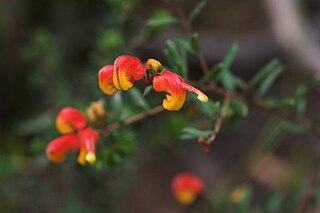
The Australian flowering shrub Grevillea alpina has several common names, including mountain grevillea, alpine grevillea, and cat's claws. It is not limited to alpine environments, and in fact is less common at high elevation than low. The species is variable in appearance, with five general forms described: small-flowered, Grampians, Northern Victorian, Goldfields, and Southern Hills forms. It is found in dry forests and woodlands across Victoria and into southern New South Wales. Some forms of the plant are low to the ground, and some become a spreading shrub. The flowers come in many colours, from white to green to shades of red and pink, or a pattern of several colours. The curled flowers are 1 to 3 centimetres in length. It is attractive to nectar-feeding insects and birds.
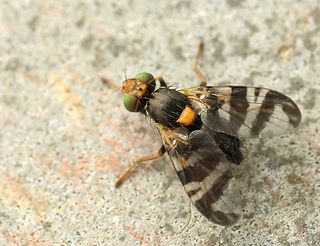
Rhagoletis is a genus of tephritid fruit flies with about 70 species.
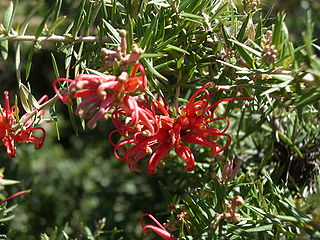
Grevillea juniperina, commonly known as juniper- or juniper-leaf grevillea or prickly spider-flower, is a plant of the family Proteaceae native to eastern New South Wales and south-eastern Queensland in Australia. Scottish botanist Robert Brown described the species in 1810, and seven subspecies are recognised. One subspecies, G. j. juniperina, is restricted to Western Sydney and environs and is threatened by loss of habitat and housing development.

Taxandria juniperina commonly known as wattie, native cedar, Warren River cedar or juniper myrtle is a species of tree that grows in the south west corner of Western Australia. This plant was previously classified as Agonis juniperina but is now part of the genus Taxandria. The Noongar peoples know the tree as watti.
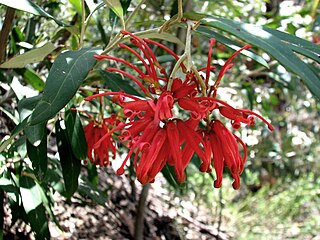
Grevillea victoriae, also known as royal grevillea or mountain grevillea, is a shrub which is endemic to south-eastern New South Wales and mountainous parts of Victoria in Australia.

Rhagoletis cerasi is a species of fruit fly in the family Tephritidae.
Rhagoletis acuticornis is a species of tephritid or fruit flies in the genus Rhagoletis of the family Tephritidae.
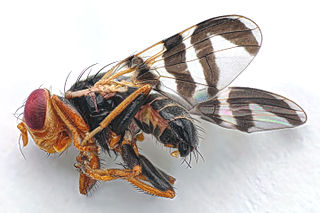
Rhagoletis batava is a species of tephritid or fruit flies in the genus Rhagoletis of the family Tephritidae. Rhagoletis batava larvae feed inside fruit flesh, and can be important pest of seabuckthorn. This species is very similar to Rhagoletis cerasi
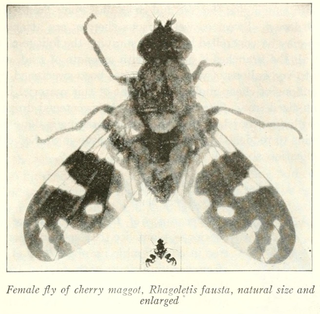
Rhagoletis fausta, the black-bodied cherry fruit fly, is a species of tephritid or fruit flies in the genus Rhagoletis of the family Tephritidae. It is found in the United States and Canada.
Rhagoletis juglandis, also known as the walnut husk fly, is a species of tephritid or fruit fly in the family Tephritidae. It is closely related to the walnut husk maggot Rhagoletis suavis. This species of fly belongs to the R. suavis group, which has a natural history consistent with allopatric speciation. The flies belonging to this group are morphologically distinguishable.

Rhagoletis suavis, also known as the walnut husk maggot, is a species of tephritid or fruit fly in the family Tephritidae. This fly is closely related to, but not to be confused with, Rhagoletis juglandis, or the walnut husk fly. It occurs in North America.

Leptecophylla juniperina is a species of flowering plant in the family Ericaceae. The species is native to New Zealand and the Australian states of Tasmania and Victoria. The plant's fruit is edible, raw or cooked. Plants grow best in areas with moderate winters and cool moist summers.

Grevillea parvula , commonly known as Genoa grevillea, is a species of the plant genus Grevillea. It is native to the states of Victoria and New South Wales in Australia.

Pultenaea juniperina, known by the common names prickly beauty and prickly bush-pea, is a native Australian plant belonging to the family Fabaceae. Taking the form of a spiky shrub up to 1.5 m tall with abundant yellow-orange pea flowers typical of Fabaceae, P. juniperina is widespread across southeast Australia, particularly present in southeast Victoria and across Tasmania.

Persoonia juniperina, commonly known as prickly geebung, is a species of flowering plant in the family Proteaceae and is endemic to south-eastern Australia. It is a small erect to low-lying shrub with smooth bark, hairy new branches, linear leaves, yellow flowers borne singly or in groups of up to forty in leaf axils, and yellowish green to purplish fruit.
Clastoptera juniperina, the juniper spittlebug, is a species of spittlebug in the family Clastopteridae. It is found in North America.

Chlorochroa juniperina is a European species of shield bug in the tribe Nezarini. C. juniperina is distributed in mainland Europe from France through to Scandinavia, but became extinct in England in 1925 due to the decline of juniper, its host.














